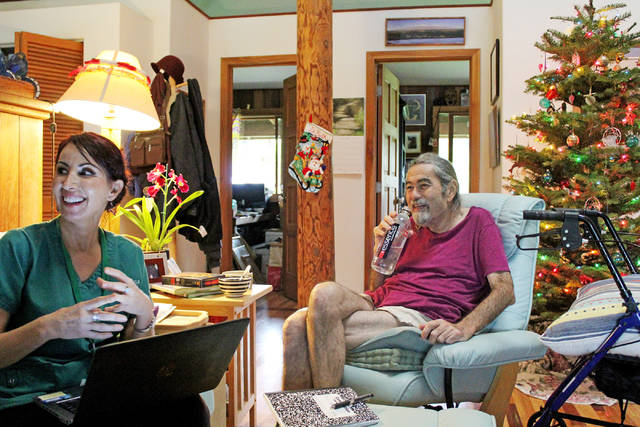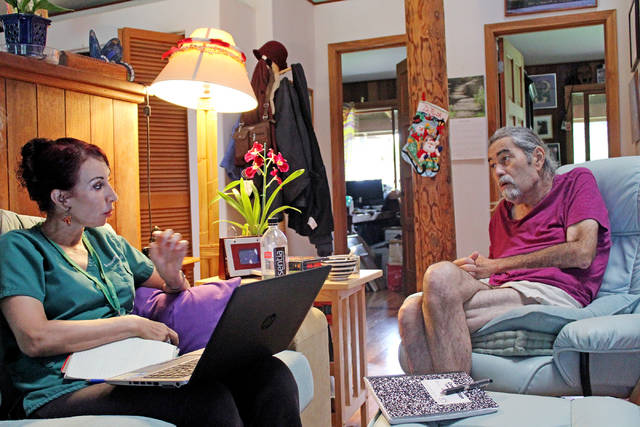Editor’s Note: This is the fourth story in an occasional series, called “The Dying Project,” about the dying process of Daniel Morii, who, along with his spouse, Shari, invited the community and the Hawaii Tribune-Herald to follow their experiences.
Daniel Morii of Hakalau, who has cancer and was diagnosed as terminal earlier this year, transitioned to hospice care.
Morrii previously was using Hospice of Hilo’s Kupu Care program. Kupu Care, named after kupukupu — ferns that are among the first plants to grow after fresh lava cools — is available for people with cancer or congestive heart failure. It’s intended to help ease the burdens of illness.
Hospice, by contrast, becomes appropriate once a terminally ill person no longer is seeking cures, said Hospice of Hilo social worker Anne Andersen.
Hospice can provide palliative care, such as pain control; assistive devices, such as walkers, canes and wheelchairs; and visits from nurses, counselors and volunteers experienced with the dying process.
“You get equipment. You also have access to the 24-hour call-in line, which is nice,” Andersen said.
Hospice providers help patients maintain a high quality of life while addressing the many difficult hurdles terminal illness can present.
Morii recently got a walker that converts to a chair. It helps him walk from room to room with the option to sit down and rest whenever he needs to.
Even so, his spouse, Shari, worries about his safety.
This is a period when Morii remains relatively active but might spontaneously need help pulling something down from a shelf, an arm to steady his gait or someone to converse with late at night when sleep disruption hits.
Morii and his wife must, by necessity, accept their privacy is limited when outside help is needed.
Morii’s longtime friends and family carefully created a schedule of loving volunteers to support him with caregiving needs — and his wife with caregiver needs.
Hospice, too, keeps Morii and his loved ones in mind.
“We don’t just work with Daniel,” Andersen said. “We work with the whole crew, the whole ohana.”
Morii experienced a dramatic decline in his ability to function during the week of Thanksgiving, when he organized a gathering of friends and family at a retreat near his home.
An ER visit and pain medicine helped him sleep — but he missed the chance to have Thanksgiving Day food and mingle.
“I have no memory of that time,” he said. “It’s like the lost days.”
Medication changes helped better control his pain and he regained the ability to stay aware and also some of his mobility. Recently, he even ventured out with a friend for a visit to town.
“Out into the world,” Morii said as he headed toward the door. “It’s been awhile.”
But he’s spending more and more time at home, and that’s to be expected.
Hospice of Hilo offers “support, guidance and compassionate care of body, mind and spirit” for its patients.
But as Morii’s disease progresses, hospice also is becoming a leaning post for family members and friends to rest upon — a common experience for people who use hospice.
“We also have a very supportive community here in Hakalau,” Shari Morii said.
The primary family caregiver role during terminal illness, “I’d have to say, is the toughest thing that a person could ever do,” Andersen said. It includes grieving the impending loss of a loved one — but also allowing that person to grieve.
Now that Morii has become a hospice patient, Andersen said, “the nurse will visit every week — and more, if necessary.”
Email Jeff Hansel at jhansel@hawaiitribune-herald.com.




